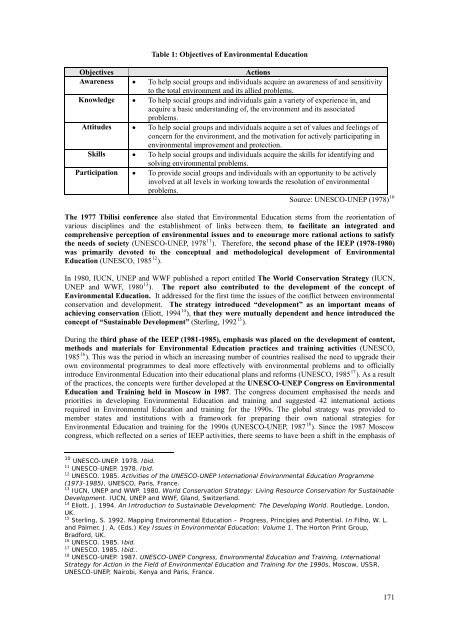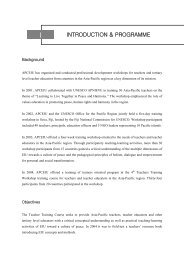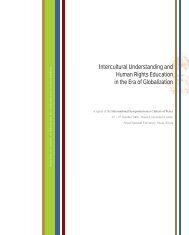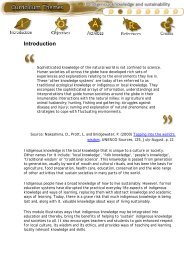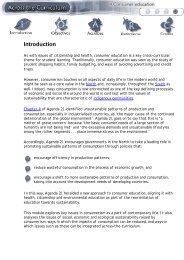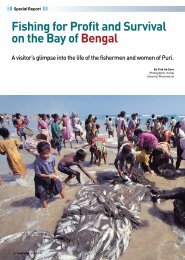REPORT OF UNESCO EXPERT MEETING ON - APCEIU
REPORT OF UNESCO EXPERT MEETING ON - APCEIU
REPORT OF UNESCO EXPERT MEETING ON - APCEIU
Create successful ePaper yourself
Turn your PDF publications into a flip-book with our unique Google optimized e-Paper software.
Table 1: Objectives of Environmental Education<br />
Objectives<br />
Actions<br />
Awareness • To help social groups and individuals acquire an awareness of and sensitivity<br />
to the total environment and its allied problems.<br />
Knowledge • To help social groups and individuals gain a variety of experience in, and<br />
acquire a basic understanding of, the environment and its associated<br />
problems.<br />
Attitudes • To help social groups and individuals acquire a set of values and feelings of<br />
concern for the environment, and the motivation for actively participating in<br />
environmental improvement and protection.<br />
Skills • To help social groups and individuals acquire the skills for identifying and<br />
solving environmental problems.<br />
Participation • To provide social groups and individuals with an opportunity to be actively<br />
involved at all levels in working towards the resolution of environmental<br />
problems.<br />
Source: <strong>UNESCO</strong>-UNEP (1978) 10<br />
The 1977 Tbilisi conference also stated that Environmental Education stems from the reorientation of<br />
various disciplines and the establishment of links between them, to facilitate an integrated and<br />
comprehensive perception of environmental issues and to encourage more rational actions to satisfy<br />
the needs of society (<strong>UNESCO</strong>-UNEP, 1978 11 ). Therefore, the second phase of the IEEP (1978-1980)<br />
was primarily devoted to the conceptual and methodological development of Environmental<br />
Education (<strong>UNESCO</strong>, 1985 12 ).<br />
In 1980, IUCN, UNEP and WWF published a report entitled The World Conservation Strategy (IUCN,<br />
UNEP and WWF, 1980 13 ). The report also contributed to the development of the concept of<br />
Environmental Education. It addressed for the first time the issues of the conflict between environmental<br />
conservation and development. The strategy introduced “development” as an important means of<br />
achieving conservation (Eliott, 1994 14 ), that they were mutually dependent and hence introduced the<br />
concept of “Sustainable Development” (Sterling, 1992 15 ).<br />
During the third phase of the IEEP (1981-1985), emphasis was placed on the development of content,<br />
methods and materials for Environmental Education practices and training activities (<strong>UNESCO</strong>,<br />
1985 16 ). This was the period in which an increasing number of countries realised the need to upgrade their<br />
own environmental programmes to deal more effectively with environmental problems and to officially<br />
introduce Environmental Education into their educational plans and reforms (<strong>UNESCO</strong>, 1985 17 ). As a result<br />
of the practices, the concepts were further developed at the <strong>UNESCO</strong>-UNEP Congress on Environmental<br />
Education and Training held in Moscow in 1987. The congress document emphasised the needs and<br />
priorities in developing Environmental Education and training and suggested 42 international actions<br />
required in Environmental Education and training for the 1990s. The global strategy was provided to<br />
member states and institutions with a framework for preparing their own national strategies for<br />
Environmental Education and training for the 1990s (<strong>UNESCO</strong>-UNEP, 1987 18 ). Since the 1987 Moscow<br />
congress, which reflected on a series of IEEP activities, there seems to have been a shift in the emphasis of<br />
10 <strong>UNESCO</strong>-UNEP. 1978. Ibid.<br />
11 <strong>UNESCO</strong>-UNEP. 1978. Ibid.<br />
12 <strong>UNESCO</strong>. 1985. Activities of the <strong>UNESCO</strong>-UNEP International Environmental Education Programme<br />
(1973-1985), <strong>UNESCO</strong>, Paris, France.<br />
13 IUCN, UNEP and WWP. 1980. World Conservation Strategy: Living Resource Conservation for Sustainable<br />
Development. IUCN, UNEP and WWF, Gland, Switzerland.<br />
14 Eliott, J. 1994. An Introduction to Sustainable Development: The Developing World. Routledge, London,<br />
UK.<br />
15 Sterling, S. 1992. Mapping Environmental Education – Progress, Principles and Potential. In Filho, W. L.<br />
and Palmer, J. A. (Eds.) Key Issues in Environmental Education: Volume 1. The Horton Print Group,<br />
Bradford, UK.<br />
16 <strong>UNESCO</strong>. 1985. Ibid.<br />
17 <strong>UNESCO</strong>. 1985. Ibid..<br />
18 <strong>UNESCO</strong>-UNEP. 1987. <strong>UNESCO</strong>-UNEP Congress, Environmental Education and Training, International<br />
Strategy for Action in the Field of Environmental Education and Training for the 1990s, Moscow, USSR,<br />
<strong>UNESCO</strong>-UNEP, Nairobi, Kenya and Paris, France.<br />
171


